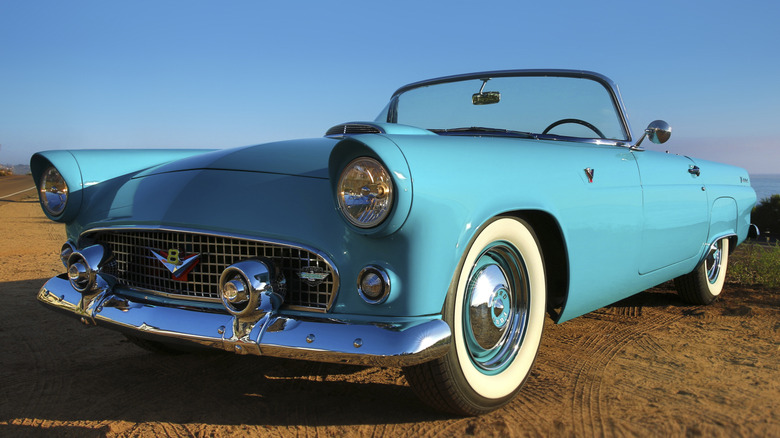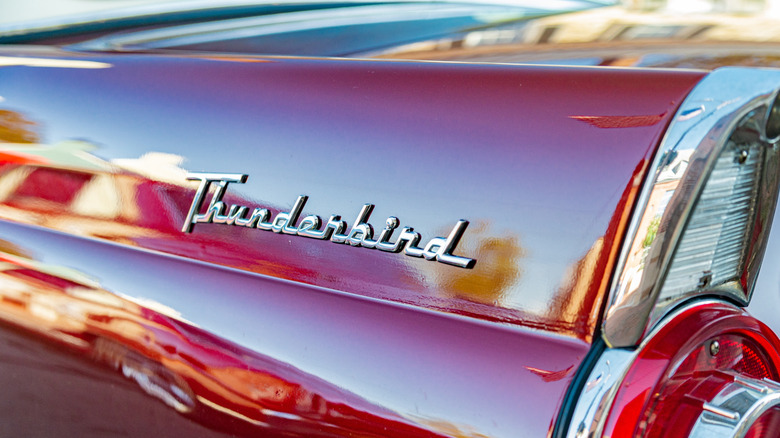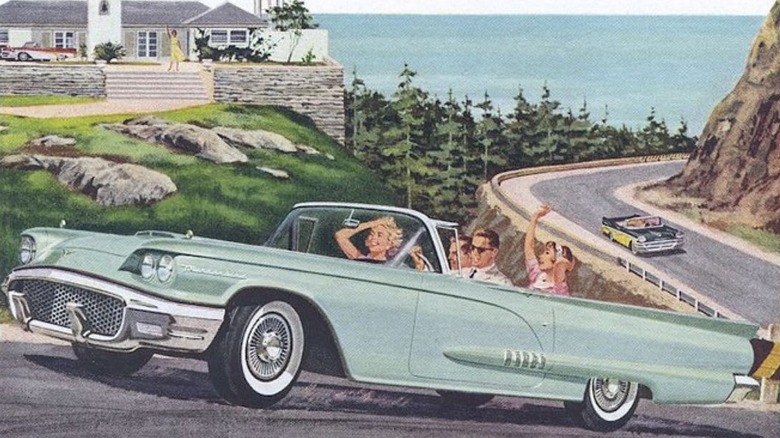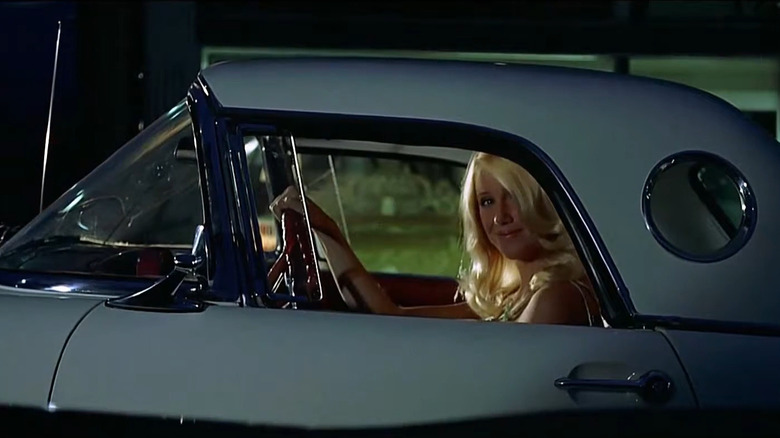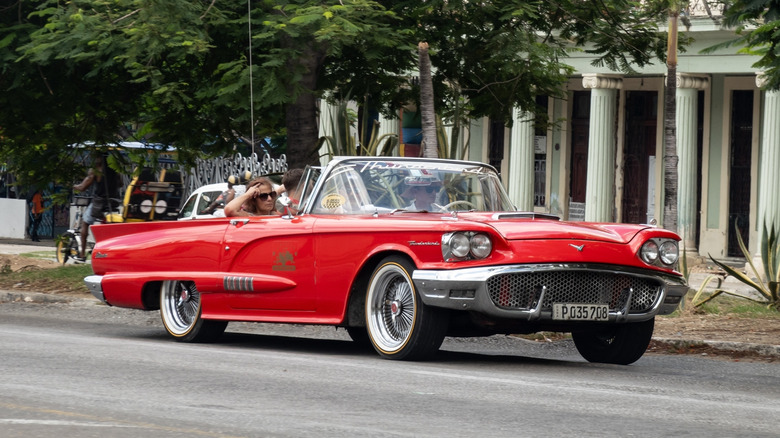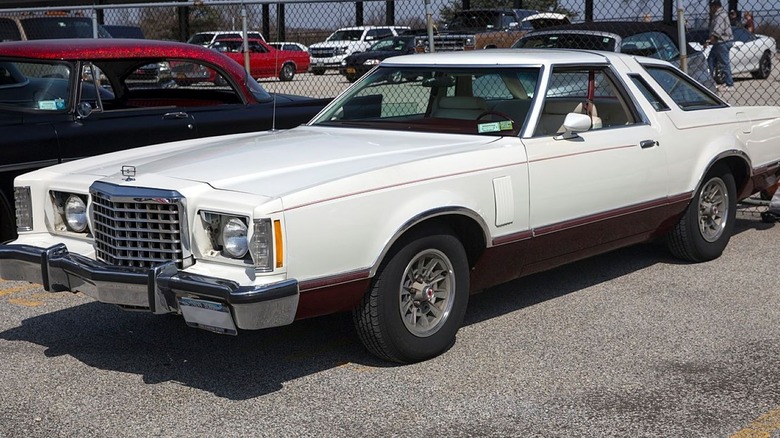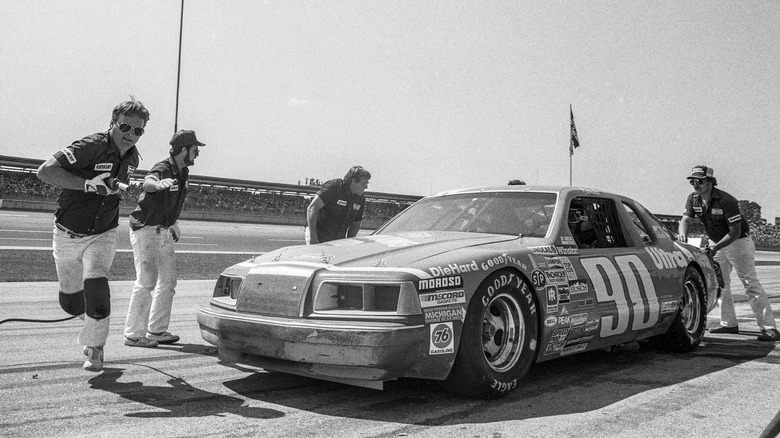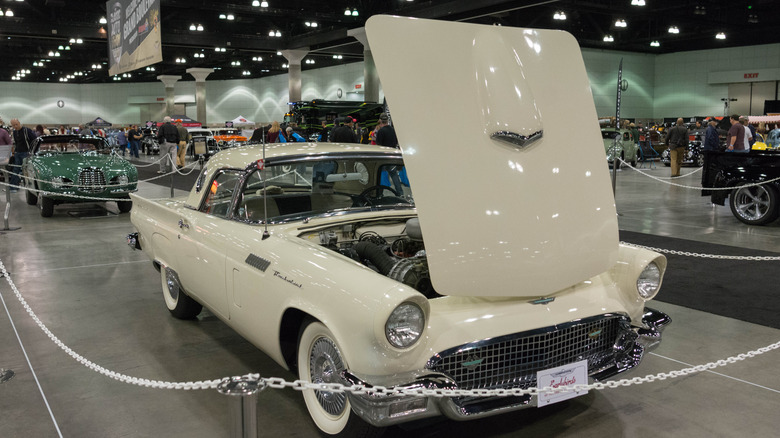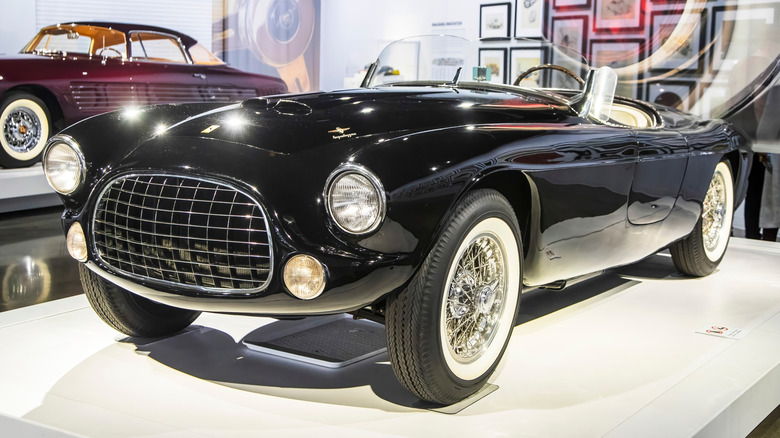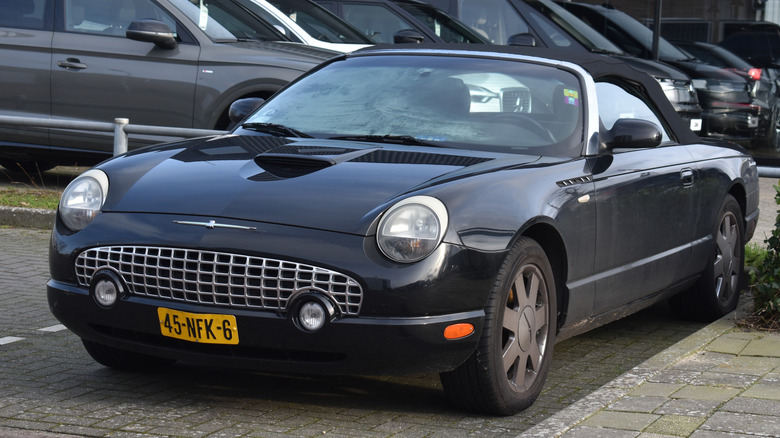9 Fun Thunderbird Facts Every Ford Enthusiast Should Know
Whenever Ford sports cars enter the conversation, people hearken back to the same few names. From the everyman Ford Mustang that seems to do everything well to the supercar-eating GT40 mounting podiums at Le Mans, Ford has a long and proud lineage of performance.Yet, one Ford has slipped under the radar and down the stream of time.
Once the premier sports car in the Ford line, the Thunderbird left production for good in 2005 after a career spanning 50 years. For Americans of a certain age, the Thunderbird brings back memories of poodle skirts and canoodling over milkshakes at the local corner shop, but that's not its only legacy.
Over 11 model generations, the T-Bird served as everything from a sporty convertible to a race car to a sensible commuter before going out with a flash as a retro reimagining. Gone but not forgotten, there's no argument that the legacy of the mighty Thunderbird remains secure.
Whatever your favorite iteration, join us as we outline the facts and figures of one of the most iconic nameplates to ever emerge from a Detroit assembly plant.
It almost wasn't called the Thunderbird
You can't judge a book by its cover, and you shouldn't judge a car by its name. Nonetheless, it happens. All the fancy mechanicals and low 0-60 times in the world won't save a vehicle if buyers can't see past its name.
When it came to naming the Thunderbird, the process was far from straightforward. Over 5,000 suggestions flooded into Ford, including Detroiter, Beaver, Runabout, and Savile. However, it was the Thunderbird's founding father, Lewis D. Crusoe, who had the final say. Despite not liking any of the suggestions, he was determined to find the perfect name and even offered a reward of $250 (about $3,000 today) for the winning idea.
Young Ford stylist Al Giberson was sipping his coffee, lost in thought about a potential name for the Thunderbird. As he gazed at the illustration of a two-headed bird on his mug, inspiration struck. He later submitted a list of potential names. Among them was the now-iconic Thunderbird.
The chosen name was more than just a label. Thunderbird evoked notions of strength, speed, and the exhilarating peal of thunder as it headed your way — the very characteristics Ford wanted consumers to associate with its new sports car. When the Thunderbird made its grand debut at the 1954 Detroit Auto Show, it was more than just a car — it was a Thunderbird.
The Thunderbird became an icon in short order
The Thunderbird design spoke to a time and place in American history, even seven decades after its introduction. It captured the mood and conventions of its era, and early sales indicated Ford had scored a direct hit.
Just three years into production, the 1958 edition had already become one of the best-selling cars of its time, with nearly 38,000 models out the door. Maybe it's because Ford offered a rear set that year — all the better to neck with your date at Lookout Point.
The rear seat option wasn't the only thing the T-bird had going for it. Recognizing its potential, Ford worked diligently to include the gizmos and gadgets consumers were learning to expect from their cars. In a shift toward luxury, Ford included several upgrades. Adorably named Dial-o-matic seats moved with the power of electricity! The radio volume adjusted itself based on how hard the engine was working! Fin tails showed up on the rear fenders — just like on the rockets astronauts were only beginning to fly to space with.
For many young Americans, the late 1950s was a time of hope and potential, marked by the promise of a brighter future and the thrill of technological advancements. With its futuristic design and innovative features, the Thunderbird embraced the zeitgeist, becoming a symbol of the era's optimism and progress.
The Thunderbird has more film credits than most actors
Its iconic status propelled the Thunderbird into the pop culture arena through the 1960s. The famously car-crazy Beach Boys built an entire hit song about a young woman having fun, fun, fun until her father takes the Thunderbird back. Bob Sieger, Chuck Berry, Alan Jackson, and others followed suit, each with a unique take on the T-bird.
Records weren't the only mass media infiltrated by the Thunderbird. Hollywood got in on the action with several movies in which the iconic Ford Thunderbird takes center stage. Suzanne Somers rocked a cream hardtop '56 in "American Graffiti." Thelma and Louise clasped hands and drove a 1966 model off a cliff in eponymous movie, and Hans Zimmer also named a song from the film's score after the car. The James Bond franchise even took a taste, featuring a '64 in "Goldfinger," though the show was rightfully stolen by the debut of Bond's Aston Martin DB5. Even the rough-and-tumble T-birds led by John Travolta in 1978's "Grease" are rumored to have lifted the name from the little coupe.
Automakers don't build cars to star in movies (though they certainly don't mind if they do). The inclusion of the Thunderbird in so many pieces of American art proves that even as time has worn on, the T-Bird is firmly embedded in the history of cruising culture.
It gained nearly 1,000 pounds in one year
Initially conceived as a sports car, the Thunderbird quickly shifted focus to the luxury performance market. This shift was primarily due to changing consumer preferences and market trends. Adding an optional second set of seats wasn't the only indicator that Ford was moving in another direction. Between 1957 and 1958, the Thunderbird gained 1,000 pounds.
The biggest culprit was an elongated wheelbase. Ford added 18 inches to the vehicle's length — more room for passengers. Excessive chroming, stamped steel, power windows, seats, steering, and air conditioning also contributed to the vehicle's curb weight.
It was the sports car for the set who didn't necessarily value the rough and ready racing Corvette. Power and comfort combined proved to be the sweet spot for the T-bird, and it doubled sales in 1958, with nearly 40,000 new Thunderbirds hitting the streets.
Over a fifty-year career, the Thunderbird would continue to vacillate between the luxury and sports car markets, with ever-increasing attention paid to the luxury side.
There were 11 generations
The first few generations of Thunderbird electrified the car world, but that was only the beginning. Ford wasn't shy about shifting its property to meet the market's demands. The Thunderbird would appear in no fewer than eleven iterations throughout its lifetime. Most generations were relatively short-lived, only getting two to three years before Ford moved on.
After its initial success, Ford had difficulty finding a place for the Thunderbird in the changing market of the 1960s. The Mustang provided plenty of cheap thrills. The 1967 MotorTrend Car of the Year Winning Mercury Cougar was outperforming expectations in muscle car space. Ford's other subsidiary, Lincoln, already offered ultra-luxury aplenty, too.
The first generation ran between 1955 and 1957, the second from 1958 to 1960, the third from 1961 to 1963, the fourth from 1964 to 1966, the fifth from 1967 to 1971, the sixth between 1972 and 1976, the seventh from 1977 to 1979, the eighth between 1980 to 1982, ninth from 1983 to 1988, tenth between 1989 to 1997, and a resurrected eleventh between 2002 and 2005.
The result was an evolving and sometimes amorphous vehicle with a place in the luxury performance pack, even if no one was sure exactly where that place was. Ford ultimately axed the entire affair in 1997 before bringing the Thunderbird back in 2002, hoping to cash in on Baby Boomer nostalgia.
It has an impressive racing pedigree
Just a year after its debut, the Thunderbird astounded everyone by becoming the fastest car in the standing mile at the 1956 Speed Week at Daytona. In 1957, it achieved a remarkable 160.356 mph in a flying mile event. These events not only showcased its speed, but also its resilience, proving that the Thunderbird had substance to match its style.
The Thunderbird's prowess was also demonstrated at the Bonneville Salt Flats in Utah. L.W. Farrington pushed a '59 Thunderbird to a staggering 173 mph, setting a new speed record in the process. The Thunderbird's speed capabilities were further showcased when one hit an impressive 241 mph in 1963, cementing its reputation as a high-performance vehicle.
A special Thunderbird racing package hit NASCAR in 1959, back when stock car racing still used cars that were... stock. It made an instant impact, kicking off what would become a lengthy racing career by winning six races in its division.
Bobby Allison made history by winning the Daytona 500 in a Thunderbird after starting in 33rd position – the starting position to victory gap in NASCAR history. In 1987, driver Bill Elliott set an all-time speed record when he hit 212.809 mph while qualifying for the Winston 500.
Only eight of the rarest variety are known to still exist
Though the early Thunderbirds don't command the sky-high prices of the C1 Corvette on today's market, an ultra-rare variety recently demanded nearly a quarter million dollars. In 1957, Chevrolet introduced fuel injection in its Corvette. With a 283-cubic inch V8 making 283 hp, the fuelie 'Vette was the first American car to achieve one horsepower per cubic inch.
Ford then upped its own engine game by offering 292 and 312 cubic inch V8 engines, assigning single-letter designations to its vehicles. The 292 with a single carburetor was a C-code, while the 312 edition with a four-barrel carb was a D-code.
The ultimate expression of the Thunderbird, and one of the rarest cars Ford ever produced, was the 1957 D/F code. The F stood for the addition of a factory-installed supercharger, a McCulloch Paxton VR57 sat atop the 312 cubic inch V8. The D/F code T-birds aimed to beat a Corvette speed record set the year prior. Ford Competition produced 15 hand-built D/F racing prototypes on January 25, 1957. As it came to be known, the Phase One Thunderbird beat the Corvette's record by 6 mph at Daytona, clocking in at 137.775 mph.
Though Ford greenlit a series of supercharged Thunderbirds for the public after the success of the D/F, the Competition editions are exceedingly rare today. Only eight are believed to have survived, with one going at auction in 2021 for $247,500.
Ferrari inspired Ford
Ford and Ferrari have a tempestuous relationship. When Enzo Ferrari and Henry Ford II were alive, competition was fierce, as documented in 2019's "Ford v Ferrari." While the most famous episode in the rivalry's history led to the birth of the GT40 in the 1960s, the companies had a better relationship before Ford's 1963 failure to buy Ferrari.
In Ford efforts to outdo the Corvette, it found inspiration in an unexpected place: Ferrari's 212/225 Barchetta. Enzo Ferrari's gift of a black Barchetta to Henry Ford II in 1952 left a lasting impression. When it was time to create the Thunderbird, Ford's design team clearly drew from the sleek lines and sporty spirit of the Italian roadster, a testament to Enzo Ferrari's influence on automotive design.
Despite their differences in powerplants, the Ford Thunderbird and Ferrari Inter Barchetta share a surprising number of design elements. The hood scoops, integrated exhaust pipes, roundel taillights, and other cues reveal a strong Ferrari influence, even though the Thunderbird's primary target was the Corvette.
The Thunderbird's comeback was a miserable failure
While Ford set the world afire with its retro-inspired fifth-generation Mustang in 2004, things hadn't go so well when the Blue Oval tried something similar with the Thunderbird a couple of years earlier. After cutting production in 1997, many believed the Thunderbird to be dead and gone, only to see a vintage reimagining pop up in 2002.
Ford, which owned Jaguar at the time, debuted the 11th generation Thunderbird in Detroit at the 1999 North American International Auto Show. When a production edition arrived in 2002, a 3.9-liter V8 sourced from Jaguar making 252 hp hid under the hood. It made a decent splash; Ford moved over 31,000 that first year. But that proved to be the high water mark of the comeback. The following year, it sold half as many, and numbers continued to drop thereafter.
Ford was in no shape to carry similar vehicles — it was burning through cash in the early 2000s. With Lincoln andJaguar using the same expensive-to-produce DEW98 chassis, the Thunderbird was interesting but niche, and Ford wasn't in the financial shape to compete with itself by building a car in triplicate.
